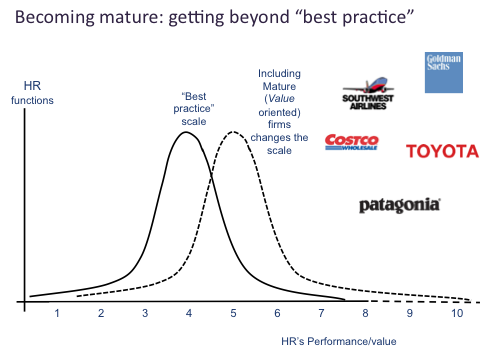 “That’s the state of play in human resources today – mindless imitation of what others are doing, little to no systematic evaluation of the effectiveness of management practices and programs, infrequent data-driven diagnoses of the problems HR is expected to address – in short, little of the professionalism now almost taken for granted in medicine, to take just one example.” Professor Jeffrey Pfeffer in “Professional HR” by Paul Kearns (Routledge, 2013)
“That’s the state of play in human resources today – mindless imitation of what others are doing, little to no systematic evaluation of the effectiveness of management practices and programs, infrequent data-driven diagnoses of the problems HR is expected to address – in short, little of the professionalism now almost taken for granted in medicine, to take just one example.” Professor Jeffrey Pfeffer in “Professional HR” by Paul Kearns (Routledge, 2013)
While advising a well known global organization on how to link their ‘human capital’ to value, I was asked more than once to explain what their peer group were doing. As with many occasions previously, it took some time for me to explain that this was not the most appropriate way forward for them. In fact, looking at what others were doing should be the last thing they do.
Unfortunately, in terms of their human systems, business leaders and managers have been fed a diet of aligning with ‘‘best practice’’ for many decades, and a whole industry has grown up around it. This industry has little incentive to change because of the enormous revenues it continues to generate. And while some may justify that adopting ‘best practice’ is identifying and using the wisdom of the crowd, my view is that this is more often merely falling in line with the rest of a large herd.
‘Best practice’ and benchmarking takes no account of context, both industry specific and organizational. What happens and may work elsewhere is likely to have no bearing on whether it can work in your organization. It also gives no account of value creation that arises from such ‘‘best practice’’. It generally identifies the average or prevailing practice (or metric), and suggests that this is desirable or something to target. It is not.
This has been incredibly damaging in a number of critical ways:
1. Human capital strategy & decision-making, that can be crucial to creating value advantages, is based on the copying of others. How can you get ahead or differentiate by imitating the ‘best’ from rest of the field?
2. It disempowers leaders & managers – the consultancy industry owns ‘‘best practice’’ and benchmarking. Many firms turn over people strategy to so called ‘expert’ third parties rather than create it themselves.
3. ‘Best practice’ skews firms away from pursuing real value goals. Instead, organizations often pursue goals such as targeting cost efficiency at the expense of real value, or simply pursue practice based on spurious claims that it will enhance performance.
At a recent Maturity Institute council meeting, we discussed a recent example of a senior HR Director of a major oil company advising us that he believed that their HR organization was operating at the cutting edge. In his terms, the organization was maximizing performance as they ensured they had adopted ‘‘best practice’’ across all they did. Of course, within the context of the current management paradigm, this may be true. But compared to organizations that do not follow a ‘best practice’ strategy, where human systems are more geared to maximizing value within their own perspective and context, there is simply a different performance scale. This is illustrated here.
 Adopting a maturity driven strategy for value creation within your own organization’s human systems means that your performance potential moves to a different scale. It is no coincidence that mature organizations are often role models for others – ironically, they become ‘benchmarks’ for others to aspire to.
Adopting a maturity driven strategy for value creation within your own organization’s human systems means that your performance potential moves to a different scale. It is no coincidence that mature organizations are often role models for others – ironically, they become ‘benchmarks’ for others to aspire to.
However, imitating these role models is, once again, not the right approach. You cannot easily replicate what works for others. But you can consider the underlying principles upon which this differentiation has been achieved. This is captured within our maturity framework. In the words of an organization that has started this journey:
“It [Maturity] has raised our [HR function] profile and credibility. It has started to change the way we engage with the business, the language we use and our philosophy…we now find solutions that match the maturity of the business, rather than just adopting ‘best practice’s.” Rod Smith, Head of HR, NSW State Water
Comments are closed